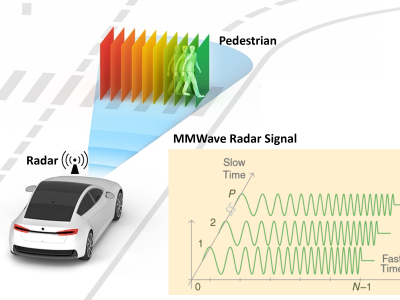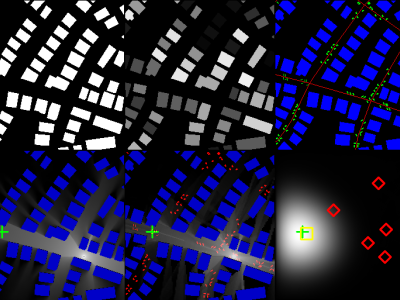CRAWDAD nist/multihop

- Citation Author(s):
-
Michael R. Souryal (National Institute of Standards and Technology)Johannes Geissbuehler (AdNovum)Kamran Sayrafian-Pour (National Institute of Standards and Technology)Andreas Wapf (National Institute of Standards and Technology)Julio Perez (National Institute of Standards and Technology)
- Submitted by:
- CRAWDAD Team
- Last updated:
- DOI:
- 10.15783/C7NK59
- Data Format:
 251 views
251 views
- Categories:
Abstract
To assess the feasibility of deploying wireless relays in real time, we conducted a series of experiments using 900 MHz TinyOS Crossbow MICA2 Motes (MPR400CB).
last modified :
2007-11-15release date :
2007-08-20date/time of measurement start :
2005-12-01date/time of measurement end :
2006-11-30collection environment :
When the range of single-hop wireless communication is limited by distance or harsh radio propagation conditions, relays can be used to extend the communication range through multihop relaying. To assess the feasibility of deploying wireless relays in real time, we conducted a series of experiments using 900 MHz TinyOS Crossbow MICA2 Motes (MPR400CB).network configuration :
A prototype system is implemented based on 900 MHz TinyOS motes supporting low-speed data applications including text messaging, sensor data and Radio Frequency Identification (RFID)-assisted localization.data collection methodology :
Please see section of each trace for the collection methodology of each experiment.Traceset
nist/multihop/experiments
Traceset of experiments for the automated deployment of a multihop wireless network.
- files: rss_success-rate.png, time_rss.png, receiver-height.png, link_symmetry.png, selection-D.png, selection-N.png, validation.png, prototype.png
- description: To assess the feasibility of deploying wireless relays in real time, we conducted a series of experiments using 900 MHz TinyOS Crossbow MICA2 Motes (MPR400CB).
- measurement purpose: Network Performance Analysis, Routing Protocol
- methodology: To assess the feasibility of deploying wireless relays in real time, we conducted the following experiments using 900 MHz TinyOS Crossbow MICA2 Motes (MPR400CB). - RSS-based Link Assessment The purpose of the first experiment was to determine whether the received signal strength (RSS) measurement of the motes is a useful predictor of link quality and, if so, to characterize the relationship between link reliability and RSS. Results were collected using a layout of 12 transmitter locations and 10 receiver locations on a single floor of an office building. The layout is shown in [Figure: Layout] (Layout for RSS-based link assessment experiment), where transmitter locations are triangles and receiver locations are stars. The result of this experiment is shown in [Figure: success rate vs. RSS] (Packet success rate vs. received signal strength), which plots the percentage of correctly decoded packets as a function of the average RSS (one data point for each batch received by a mote). - Temporal Variability of a Mobile Link We measured RSS from a mobile receiver to gain an appreciation for the extent of fluctuations of RSS at pedestrian speeds in a typical building environment, The result of this experiment is shown in [Figure: RSS vs. time] (Received signal strength vs. time at a mobile receiver), which plots the measured RSS as a function of time. - Receiver Height We measured RSS from receivers positioned at different heights, with a fixed transimitter positioned at 38 cm above the floor. The motivation of this experiment is that a practical consideration in many applications of realtime relay deployment is the effect of a receiver's height on the quality of the link. For example, if the transceiver monitoring link quality is positioned at a given height, we wish to know if there is a consistent degradation in link quality if the new relay is deployed at a different height, say on the floor. A scenario of this type might be a first responder with a monitoring radio strapped to his/her belt along with a canister ejecting relays onto the floor as needed. The result of this experiment is shown in [Figure: RSS vs. receiver height] (Received signal strength vs. tx-rx distance and receiver height), which plots the average RSS as a function of transmitter-receiver distance for each of the three receiver heights. The first six distance measurements were made with line-of-sight (LOS) links, while the last two (beyond 23 m) were non-LOS. - Link Symmetry To test RSS symmetry, we compared the RSS measured at each end of a fixed point-to-point link. The result of this experiment is shown in [Figure: Link Symmetry], (Instantaneous received signal strength of received packets and acknowledgments), which plots the instantaneous RSS measurements made on receipt of the packets and the ACKs for both links over a total duration of 250 s. - Parameter Selection for the relay deployment algorithm in [soryal-multihop] (See Section 5 in [souryal-multihop] for details of the relay deployment algorithm.) Implementation of the deployment algorithm requires selecting values for parameters including the probe period (D), the RSS averaging filter length (N), and the threshold for triggering deployment (Sth). Values for the probe period D and averaging filter length N were selected after studying the performance of the algorithm for different (D, N) pairs. The product D*N represents the duration of the observation window over which the RSS average is computed. 1. Selection of the probe period [Figure: Selection of probe period D] (Deviation from deployment threshold for three different choices of probe period D and RSS filter length N) shows the results of four separate trials for each of three pairs of (D, N). The trials consisted of two different paths, and two trials of each path. Results are given in terms of the difference between the steady-state RSS and the deployment threshold, chosen here to be Sth = -80 dBm. 2. Selection of the RSS filter length We then examined different choices of the RSS filter length, N. [Figure: Selection of the RSS filter length N] (Figure: Deviation from deployment threshold vs. RSS filter length N; probe period D = 100 ms) illustrates results of trials for four different values of N and a fixed probe period of D = 100ms. 3. Validation The choices of N = 20 and D = 100ms appears to strike a balance between consistency and latency. Five additional trials of this choice of parameters were done, and the results are shown in [Figure: Validation] (Deviation from deployment threshold with probe period D = 100 ms and RSS filter length N = 20). - Experimental Trials The prototype for real-time network deployment was tested in the eleven-story Administration building on the main campus of the National Institute of Standards and Technology. In each trial, the base node was located in the ground floor lobby. The mobile node was started next to the base, was walked to a stairwell and then up to the top floor, with relays being placed on the floor when indicated by the deployment algorithm [souryal-multihop]. After stopping at the top for data collection, the mobile node was then walked down the same path to the base node on the ground floor, passing the relays that were deployed on the way up. In most cases, we were able to reach the 10th or 11th floor with 9 deployed relays. Typically, 2 relays were deployed between the base node and the stairwell door, and the remainder were deployed inside the stairwell, roughly one relay per 1 1/2 floors. During the deployment phase, the stop phase, and the return phase, message traffic was automatically generated by the base node application to measure delivery rates and round-trip delays. Specifically, a ping-like message was sent every 4 s to the mobile node's mote, which sent a reply to the base. While at the top of the building, the base node application also sent automatically generated text messages every 4 s to the peer application on the mobile node's PDA. The PDA logged each message that was received and replied to it with a text message. Round-trip delay and delivery rate were measured from the ping messages, and one-way delivery rates were measured from the auto-text messages. The result of this experiment is shown in [Figure: Prototype] (Ping roundtrip delay vs. time of trial 3), which plots ping roundtrip delay over the course of trial 3.
- last modified: 2007-11-15
- dataname: nist/multihop/experiments
- version: 20070820
- change: the initial version.
- release date: 2007-08-20
- date/time of measurement start: 2005-12-01
- date/time of measurement end: 2006-11-30
nist/multihop/experiments Traces
- rss_success-rate: Trace of RSS-based link assessment for the automated deployment of a multihop wireless network.
- configuration: At each transmitter location, a batch of 200 packets was transmitted, and the receivers recorded the sequence number, CRC result and RSS (in dBm) of each detected packet. The transmitter repeated the transmission batch at six different transmission power levels, (-20, -15, -10, -5, 0 and 5) dBm, in order to obtain a finer range of RSS data points. The result of this experiment is shown in [Figure: Packet success rate vs. received signal strength], which plots the percentage of correctly decoded packets as a function of the average RSS (one data point for each batch received by a mote).
- format: The file "rss_success-rate.txt" consists of: - first column: avg rss (dBm) - second column: pkt succ rate
- description: Trace of RSS-based link assessment for the automated deployment of a multihop wireless network.
- last modified: 2007-11-15
- dataname: nist/multihop/experiments/rss_success-rate
- version: 20070820
- change: the initial version
- release date: 2007-08-20
- date/time of measurement start: 2005-12-01
- date/time of measurement end: 2006-11-30
- url: /download/nist/multihop/souryal_mobisys2007_figs/rss_success-rate.png
- time_rss: Trace of RSS measurement with a mobile receiver for the automated deployment of a multihop wireless network.
- configuration: We placed a receiver on a small vehicle moving down an office corridor away from a fixed transmitter at a speed of approximately 0.3 m/s. The total distance covered was 20 m. Packets were transmitted at a rate of 50 packets/s, and the mobile receiver recorded the RSS of each detected packet. The result of this experiment is shown in [Figure: Received signal strength vs. time at a mobile receiver], which plots the measured RSS as a function of time.
- format: The file "time_rss.txt" consists of: - first column: time (sec) - second column: rss (dBm)
- description: Trace of RSS measurement with a mobile receiver for the automated deployment of a multihop wireless network.
- last modified: 2007-11-15
- dataname: nist/multihop/experiments/time_rss
- version: 20070820
- change: the initial version
- release date: 2007-08-20
- date/time of measurement start: 2005-12-01
- date/time of measurement end: 2006-11-30
- url: /download/nist/multihop/souryal_mobisys2007_figs/time_rss.png
- receiver-height: Trace of RSS measurement with different receiver heights for the automated deployment of a multihop wireless network.
- configuration: A fixed transmitter positioned at 38 cm above the floor of an office corridor transmitted packets to a fixed receiver positioned at one of three heights above the floor: 120 cm, 38 cm, and directly on the floor. The experiment was repeated at several transmitter-receiver separation distances. At each distance and height, 250 packets were transmitted, and the receiver logged the RSS of each detected packet. The result of this experiment is shown in [Figure 4: Received signal strength vs. tx-rx distance and receiver height], which plots the average RSS as a function of transmitter-receiver distance for each of the three receiver heights. The first six distance measurements were made with line-of-sight (LOS) links, while the last two (beyond 23 m) were non-LOS.
- format: The file "receiver-height.txt" consists of: - first column: tx-rx dist (m) - second column: average rss of a receiver at 120 cm high (dBm) - third column: average rss of a receiver at 38 cm high (dBm) - fourth column: average rss of a receiver at on floor (dBm)
- description: Trace of RSS measurement with different receiver heights for the automated deployment of a multihop wireless network.
- last modified: 2007-11-15
- dataname: nist/multihop/experiments/receiver-height
- version: 20070820
- change: the initial version
- release date: 2007-08-20
- date/time of measurement start: 2005-12-01
- date/time of measurement end: 2006-11-30
- url: /download/nist/multihop/souryal_mobisys2007_figs/receiver-height.png
- link-symmetry: Trace of RSS measurement in bidirectional link for the automated deployment of a multihop wireless network.
- configuration: One transceiver transmitted 1000 packets at a rate of 4 packets/s, and the other transceiver immediately replied with an acknowledgment (ACK) for each packet it successfully received using the built-in ACK of theMAC. The second transceiver recorded the RSS of each packet it detected, while the first transceiver recorded the RSS of each ACK it detected. In this way, we were able to make nearly simultaneous measurements of the RSS in both directions of the link. Measurements were taken for a relatively strong link (approximately 2 m, LOS) and a second link roughly 20 dB weaker (approximately 7 m, non-LOS). Using a spectrum analyzer, we observed no other emissions on the same 900 MHz channel (i.e., an interference-free environment). To test RSS symmetry, we compared the RSS measured at each end of a fixed point-to-point link. The result of this experiment is shown in [Figure: Instantaneous received signal strength of received packets and acknowledgments], which plots the instantaneous RSS measurements made on receipt of the packets and the ACKs for both links over a total duration of 250 s.
- format: The file "link-symmetry.txt" consists of: - first column: packet no. - second column: rss of Link 1 Packet (dBm) - third column: rss of Link 1 ACK (dBm) - fourth column: rss of Link 2 Packet (dBm) - fifth column: rss of Link 2 ACK (dBm)
- description: Trace of RSS measurement in bidirectional link for the automated deployment of a multihop wireless network.
- last modified: 2007-11-15
- dataname: nist/multihop/experiments/link-symmetry
- version: 20070820
- change: the initial version
- release date: 2007-08-20
- date/time of measurement start: 2005-12-01
- date/time of measurement end: 2006-11-30
- url: /download/nist/multihop/souryal_mobisys2007_figs/link_symmetry.png
- selection-D: Trace of an experiment for parameter selection for the automated deployment of a multihop wireless network.
- configuration: To implement the deployment algorithm requires, we tried to select values for parameters including the probe period (D), the RSS averaging filter length (N), and the threshold for triggering deployment (Sth). We tested values for (D, N) corresponding to a fixed observation window of D = 4 seconds. For each trial, the measuring node executing the real-time link assessment algorithm (Section 4 in [souryal-multihop]) was carried away from a fixed relay in an office building environment at walking speed. When the measuring node gave the indication to deploy, the node was placed on the floor and a long sequence of packet transmissions was initiated over the fixed link to measure the steady-state RSS. The result for selecting the probe period (D) is shown in [Figure: Deviation from deployment threshold for three different choices of probe period D and RSS filter length N]. The plot shows the results of four separate trials for each of three pairs of (D, N). The trials consisted of two different paths, and two trials of each path. Results are given in terms of the difference between the steady-state RSS and the deployment threshold, chosen here to be Sth = -80 dBm.
- format: The file "selection-D.txt" consists of: - first column: RSS-Sth with Delt=100 N=40 (dB) - second column: RSS-Sth with Delt=200, N=20 (dB) - third column: RSS-Sth with Delt=500, N=8 (dB)
- description: Trace of an experiment for parameter selection for the automated deployment of a multihop wireless network.
- last modified: 2007-11-15
- dataname: nist/multihop/experiments/selection-D
- version: 20070820
- change: the initial version
- release date: 2007-08-20
- date/time of measurement start: 2005-12-01
- date/time of measurement end: 2006-11-30
- url: /download/nist/multihop/souryal_mobisys2007_figs/selection-D.png
- selection-N: Trace of an experiment for parameter selection for the automated deployment of a multihop wireless network.
- configuration: To implement the deployment algorithm requires, we tried to select values for parameters including the probe period (D), the RSS averaging filter length (N), and the threshold for triggering deployment (Sth). We tested values for (D, N) corresponding to a fixed observation window of D = 4 seconds. For each trial, the measuring node executing the real-time link assessment algorithm (Section 4 in [souryal-multihop]) was carried away from a fixed relay in an office building environment at walking speed. When the measuring node gave the indication to deploy, the node was placed on the floor and a long sequence of packet transmissions was initiated over the fixed link to measure the steady-state RSS. The result for selecting the averaging filter length (N) is shown in [Figure: Deviation from deployment threshold vs. RSS filter length N; probe period D = 100 ms]. The plot shows the results of trials for four different values of N and a fixed probe period of D = 100ms.
- format: The file "selection-N.txt" consists of: - first column: RSS-Sth with Delt=100 N=5 (dB) - second column: RSS-Sth with Delt=100, N=10 (dB) - third column: RSS-Sth with Delt=100, N=20 (dB) - fourth column: RSS-Sth with Delt=100, N=40 (dB)
- description: Trace of an experiment for parameter selection for the automated deployment of a multihop wireless network.
- last modified: 2007-11-15
- dataname: nist/multihop/experiments/selection-N
- version: 20070820
- change: the initial version
- release date: 2007-08-20
- date/time of measurement start: 2005-12-01
- date/time of measurement end: 2006-11-30
- url: /download/nist/multihop/souryal_mobisys2007_figs/selection-N.png
- validation: Trace of an experiment for parameter selection for the automated deployment of a multihop wireless network.
- configuration: To implement the deployment algorithm requires, we tried to select values for parameters including the probe period (D), the RSS averaging filter length (N), and the threshold for triggering deployment (Sth). We tested values for (D, N) corresponding to a fixed observation window of D = 4 seconds. For each trial, the measuring node executing the real-time link assessment algorithm (Section 4 in [souryal-multihop]) was carried away from a fixed relay in an office building environment at walking speed. When the measuring node gave the indication to deploy, the node was placed on the floor and a long sequence of packet transmissions was initiated over the fixed link to measure the steady-state RSS. The choices of N = 20 and D = 100ms appears to strike a balance between consistency and latency. Five additional trials of this choice of parameters were done, and the results are shown in [Figure: Deviation from deployment threshold with probe period D = 100 ms and RSS filter length N = 20].
- format: The file "validation.txt" consists of: - first column: RSS-Sth with Delt=100 N=20 (dB)
- description: Trace of an experiment for parameter selection for the automated deployment of a multihop wireless network.
- last modified: 2007-11-15
- dataname: nist/multihop/experiments/validation
- version: 20070820
- change: the initial version
- release date: 2007-08-20
- date/time of measurement start: 2005-12-01
- date/time of measurement end: 2006-11-30
- url: /download/nist/multihop/souryal_mobisys2007_figs/validation.png
- prototype: Trace of experimental trials with the prototype of the automated deployment of a multihop wireless network.
- configuration: The prototype for real-time network deployment was tested in the eleven-story Administration building on the main campus of the National Institute of Standards and Technology. In each trial, the base node was located in the ground floor lobby. The mobile node was started next to the base, was walked to a stairwell and then up to the top floor, with relays being placed on the floor when indicated by the deployment algorithm [souryal-multihop]. After stopping at the top for data collection, the mobile node was then walked down the same path to the base node on the ground floor, passing the relays that were deployed on the way up. In most cases, we were able to reach the 10th or 11th floor with 9 deployed relays. Typically, 2 relays were deployed between the base node and the stairwell door, and the remainder were deployed inside the stairwell, roughly one relay per 1 1/2 floors. During the deployment phase, the stop phase, and the return phase, message traffic was automatically generated by the base node application to measure delivery rates and round-trip delays. Specifically, a ping-like message was sent every 4 s to the mobile node's mote, which sent a reply to the base. While at the top of the building, the base node application also sent automatically generated text messages every 4 s to the peer application on the mobile node's PDA. The PDA logged each message that was received and replied to it with a text message. Round-trip delay and delivery rate were measured from the ping messages, and one-way delivery rates were measured from the auto-text messages. The result of this experiment is shown in [Figure: Ping roundtrip delay vs. time of trial 3], which plots ping roundtrip delay over the course of trial 3.
- format: The file "prototype.txt" consists of: - first column: time (s) - second column: roundtrip time (s)
- description: Trace of experimental trials with the prototype of the automated deployment of a multihop wireless network.
- last modified: 2007-11-15
- dataname: nist/multihop/experiments/prototype
- version: 20070820
- change: the initial version
- release date: 2007-08-20
- date/time of measurement start: 2005-12-01
- date/time of measurement end: 2006-11-30
- url: /download/nist/multihop/souryal_mobisys2007_figs/prototype.png
Instructions:
The files in this directory are a CRAWDAD dataset hosted by IEEE DataPort.
About CRAWDAD: the Community Resource for Archiving Wireless Data At Dartmouth is a data resource for the research community interested in wireless networks and mobile computing.
CRAWDAD was founded at Dartmouth College in 2004, led by Tristan Henderson, David Kotz, and Chris McDonald. CRAWDAD datasets are hosted by IEEE DataPort as of November 2022.
Note: Please use the Data in an ethical and responsible way with the aim of doing no harm to any person or entity for the benefit of society at large. Please respect the privacy of any human subjects whose wireless-network activity is captured by the Data and comply with all applicable laws, including without limitation such applicable laws pertaining to the protection of personal information, security of data, and data breaches. Please do not apply, adapt or develop algorithms for the extraction of the true identity of users and other information of a personal nature, which might constitute personally identifiable information or protected health information under any such applicable laws. Do not publish or otherwise disclose to any other person or entity any information that constitutes personally identifiable information or protected health information under any such applicable laws derived from the Data through manual or automated techniques.
Please acknowledge the source of the Data in any publications or presentations reporting use of this Data.
Citation:
Michael R. Souryal, Johannes Geissbuehler, Kamran Sayrafian-Pour, Andreas Wapf, Julio Perez, nist/multihop, https://doi.org/10.15783/C7NK59 , Date: 20070820
Dataset Files
- souryal_mobisys2007_data.tar.gz (Size: 36.91 KB)
- layout.png (Size: 56.69 KB)
- rss_success-rate.png (Size: 52.44 KB)
- time_rss.png (Size: 88.98 KB)
- receiver-height.png (Size: 50.34 KB)
- link_symmetry.png (Size: 70.73 KB)
- selection-D.png (Size: 26.65 KB)
- selection-N.png (Size: 22.56 KB)
- validation.png (Size: 21.9 KB)
- prototype.png (Size: 33.33 KB)
















